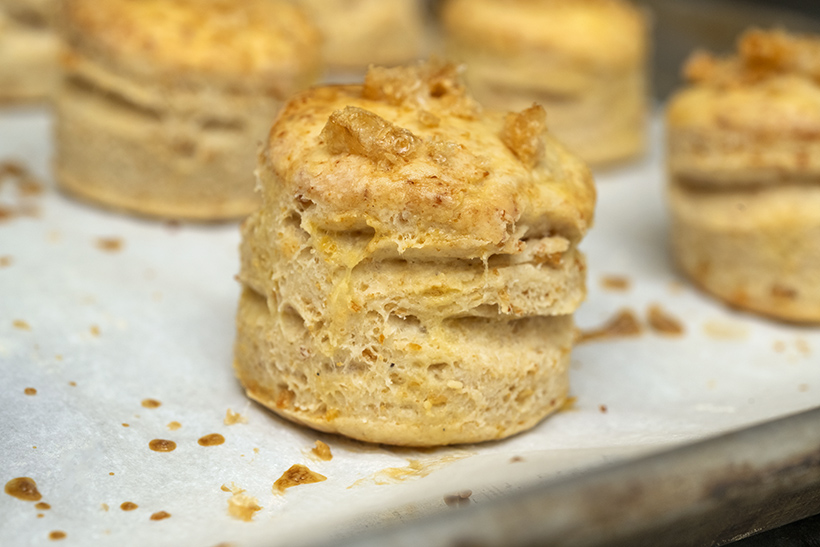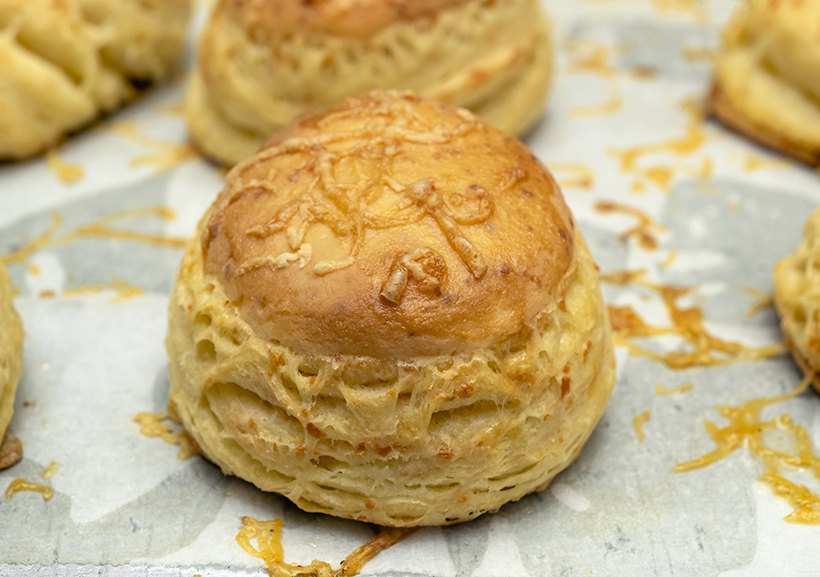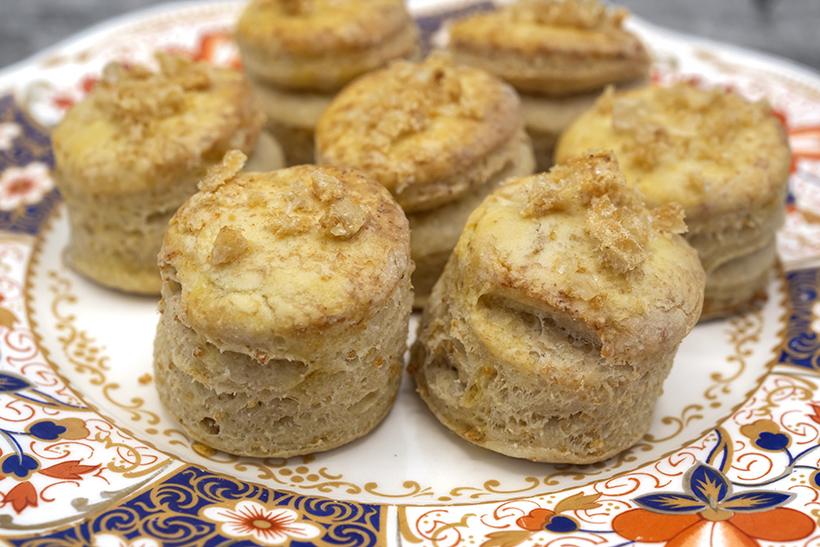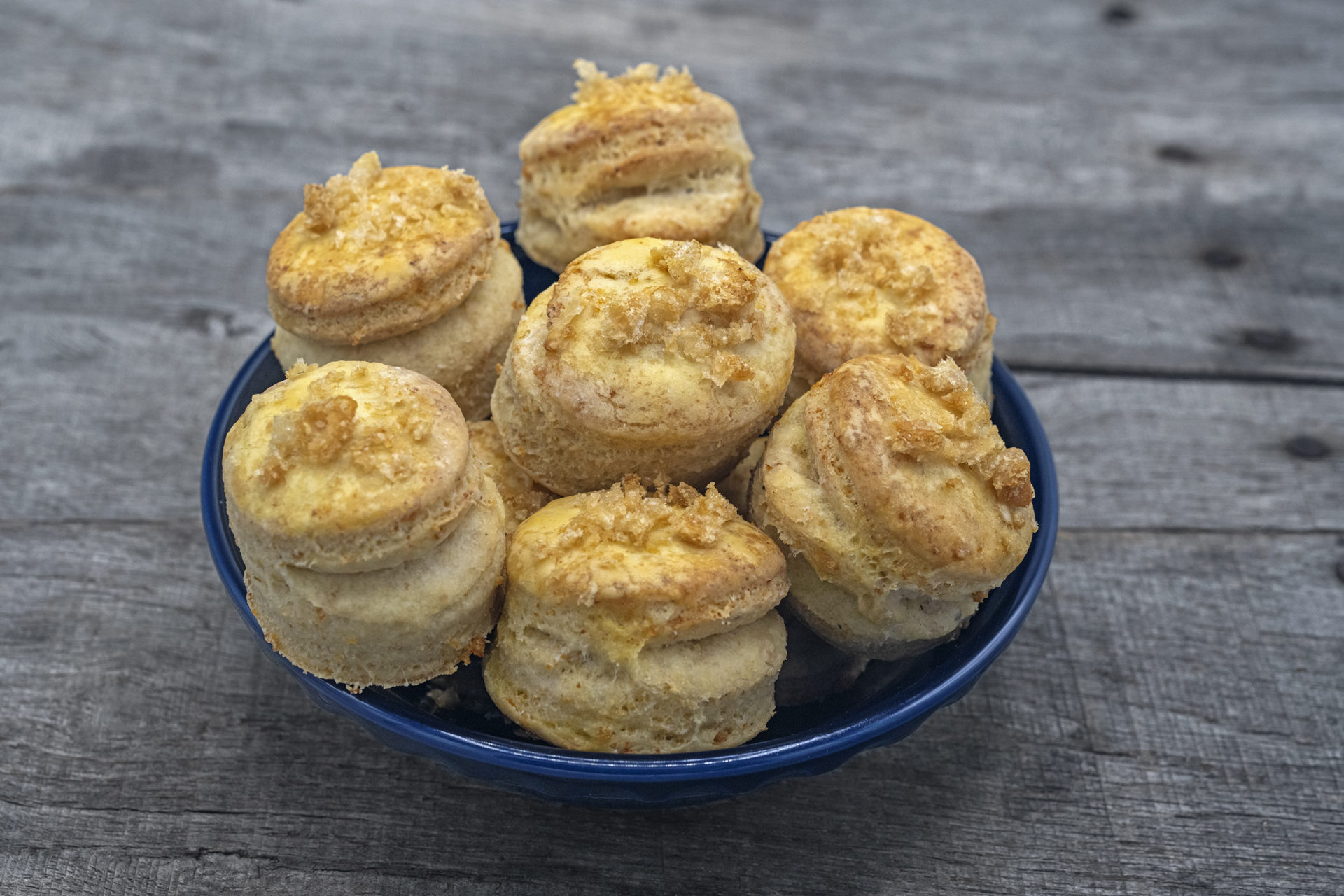You can’t visit Hungary without eating pogácsa. Whether you’re having a tasting at a winery, enjoying a drink in a bar, or attending some form of social gathering, you’re bound to encounter those little round pastries that the foreign eye easily mistakes for American Southern buttermilk biscuits or English scones. Even my meal at Michelin-starred Onyx included some of them in a bread assortment. Pogácsas, or pogis for short, go really well with alcohol, whether you’re enjoying an expensive Tokaji or just getting blotto. Yet, like many other national foods in Hungary and elsewhere, it draws its origin from another region: it’s a distant cousin of the Italian focaccia!
The word pogácsa is derived from the Latin panis focacius, meaning “bread baked on the hearth,” and entered the southern Slavic languages as pogača – remember my recipe for Vis Island pogača? Eventually, it spread to Hungary with the same pronunciation but a Magyar spelling and became a fixture of the country’s culture. In many Hungarian folk tales, the hero takes with him a pogácsa baked in embers before setting off on a long journey. On St. Luca’s name day (December 13th), a coin is hidden in a batch of pogis, and the person who finds it is said to win good luck for the following year.

One of the first written mentions of the famous pogácsa can be found in The Science of Cooking, written by the court of the Prince of Transylvania around 1580 and available in English here. Not surprisingly for medieval cuisine, many of these pogácsa recipes include rose water, almond, wine, jam, or honey. Several use grated honey kalach (after my last post, this should sound familiar) mixed with soaked pieces of bread roll instead of making dough from scratch with flour. One is made with lots of eggs and sounds like a kind of soufflé. It seems like people even decided that anything small and vaguely flat could be called pogácsa. Leftover dough cut into egg-sized pieces? Go for it! Marzipan confections? Sure! Consider then this pogácsa “for patients”, perhaps the furthest off the beaten path:
Slice a quarter of a hen into little pieces. Pit some plums, cut them into little pieces as well. Add some bread roll, flour and egg yolks. Make dough from this, then fry it.
Or the “carnival” pogácsa, a pastry hidden inside another pastry, enough to make Dominique Ansel‘s head spin:
Take a twice-baked kalach with honey, grate it and add some bread roll pieces dipped into jam and wine, mix it together; make some honey kalach dough, put it into the middle of the pogácsa, fold it; curve it a bit like a sausage, cut the dough so that there are frills at the end. Roast or fry in a pan.
Fast forward a few centuries to the cookbook of the Piarist monk Kristóf Simai: Method of Preparation of some Foods (subtitled A new and well-organized cookbook to please housewives and palates accustomed to good bites) was published in 1799 in Körmöcbánya (now Kremnica in Slovakia) and contains many types of pastries called pogácsa, usually sweet and taking various shapes. Some are made with dairy products, honey, almonds, lemon, or spices. Most are baked, but seem more like cookies than breads. Then one “cottage cheese haluška, or pogácsa” consists of a round dumpling boiled then lightly fried, and one “almond pogácsa” is a sort of almond confection with pistachios. Here’s the recipe for Simai’s butter pogácsa, the closest to what we eat today:
Take a quarter of a pound of melted butter, whisk in two beaten eggs, then add two or three tablespoons of sweet cream and mix well. Mix in a little salt and enough flour to make the mixture look like the batter for whipped haluska [use your imagination]. Tear off pieces the size of buns, place on a baking tray, brush with egg yolk to give them a nice yellow color, then put in the oven. Take them out when they’re baked to a nice red color [more like golden brown, I assume], sprinkle with sugar, and serve warm.

Skip a couple more centuries, and the pogácsa recipes found in George Lang’s Cuisine of Hungary (published in 1971) firmly belong to the biscuit category, sweet or salty. The dough, yeasted or not, is laced with butter and eggs, sometimes also sour cream or cottage cheese. The sweet versions add a little sugar, and the savory ones add pork cracklings or cabbage. Today, fifty years on, pretty much only savory biscuit varieties have survived, but there are many more, made with cheese, cabbage, beans, onions, potatoes, bacon, pork cracklings, or pumpkin seeds. The dough may be yeasted or not, sometimes folded several times to create layers.
Among these, the pork crackling pogácsa occupies a special place. The use of cracklings in pogis dates to the early 20th century. At first prepared only in the countryside after the slaughter of a pig, this pastry provided a tasty outlet for the solids that remained in the cauldron after rendering pork fat and skin to produce lard. It soon became a popular snack to eat with wine in village pubs, then conquered cities as well. The humble tepertős pogácsa was even entered in the European Union’s Traditional Speciality Guaranteed registry in 2016, and you can read all the details (in Hungarian) here. Curiously, it doesn’t appear on the official list of Hungaricums.
I’m giving you two different versions of pogácsas. The first hews fairly closely to the traditional crackling recipe as described in the EU TSG document, minus some oddities like the 0.02% white wine or vinegar, which adds up to approximately 0.1 g – if anyone ever gave me 0.1 g wine (divided into 12 portions), I’d feel seriously insulted. The second version pretty much replaces the lard and cracklings with butter and gruyère. In both cases, I’m making an airy laminated dough (as usual, some might say!) to at least give the illusion that this grease bomb of a pastry isn’t that rich, and the result is worth the extra effort. This is a departure from the typical recipe, in which a dough with the fat already roughly mixed in is rolled and folded several times without following the real lamination ritual. Even with nearly identical doughs, the lard and crackling pogácsa ends up being slightly denser than its cheese counterpart, which adds to its rustic charm. Just for fun, I calculated the nutrition facts and got approximately 150 calories per pogi. Now you’ve been warned…
Cheese or crackling pogácsa
Yields 12 pastries
Total preparation: 6 hours, for the crackling pogácsa; 5 hours for the cheese pogácsa
Active preparation: 30 minutes for either recipe
Crackling pogácsa dough
6 g active dry yeast
60 g milk, lukewarm
5 g sugar
90 g pork cracklings
260 g AP flour, plus some for dusting
7.5 g salt
0.3 g black pepper, ground
15 g egg yolk
90 g sour cream
40 g water
80 g lard, softened
- Mix the yeast, milk, and sugar in a small bowl and set aside for 10 minutes.
- Grind the pork cracklings in a blender (or food processor) by applying short buzzes on high speed. Transfer to a plastic container and reserve.
- In the bowl of a stand mixer fitted with the paddle attachment, mix the flour, salt, and pepper on low speed. Add the yeast mixture, egg yolk, sour cream, and water, and continue mixing for 5 minutes. Pour in the ground cracklings and run the mixer for another minute. Cover with plastic wrap and let rise for 2 hours, until the dough has about doubled in volume.
- Remove the dough from the bowl, gently wrap in plastic film, and refrigerate for 1 hour.
- On a floured surface, roll the dough to a 18 cm x 24 cm rectangle. With the shortest edge facing you, spread the lard on the bottom 2/3, leaving 1 cm borders clear on all sides. Fold in three, envelope style, by first bringing the top third onto the middle, then covering it with the bottom third. Be neat; make sure your rectangle (and the next ones) are as perfect as possible: stretch the corners with your fingers if they’re too round, gently press the sides with a ruler to straighten. Wrap in plastic film and refrigerate for 30 minutes.
- Return the dough to the floured surface and give it a quarter turn. Roll back to a 18 cm x 24 cm rectangle. With the shortest edge facing you, fold in three again, as described above. Repeat this process (turn, roll, fold) one more time. Wrap in plastic film and refrigerate for at least 2 hours.
Cheese pogácsa dough
6 g active dry yeast
60 g milk, lukewarm
5 g sugar
260 g AP flour, plus some for dusting
8 g salt
15 g egg yolk
80 g sour cream
40 g water
85 g aged Gruyère cheese, finely grated
95 g butter, softened
- Mix the yeast, milk, and sugar in a small bowl and set aside for 10 minutes.
- In the bowl of a stand mixer fitted with the paddle attachment, mix the flour and salt on low speed. Add the yeast mixture, egg yolk, sour cream, and water, and continue mixing for 5 minutes. Pour in the grated cheese and run the mixer for another 30 seconds. Cover with plastic wrap and let rise for 2 hours, until the dough has about doubled in volume.
- On a floured surface, roll the dough to a 18 cm x 24 cm rectangle. With the shortest edge facing you, spread the butter on the bottom 2/3, leaving 1 cm borders clear on all sides. Fold in three, envelope style, by first bringing the top third onto the middle, then covering it with the bottom third. Be neat; make sure your rectangle (and the next ones) are as perfect as possible: stretch the corners with your fingers if they’re too round, gently press the sides with a ruler to straighten. Wrap in plastic film and refrigerate for 30 minutes.
- Return the dough to the floured surface and give it a quarter turn. Roll back to a 18 cm x 24 cm rectangle. With the shortest edge facing you, fold in three again, as described above. With the shortest edge facing you, fold in three again, as described above. Repeat this process (turn, roll, fold) one more time. Wrap in plastic film and refrigerate for at least 2 hours.

Assembly
AP flour, for dusting
pogácsa dough (either of the above recipes)
10 g egg yolk
20 g water
10 g grated Gruyère cheese or coarsely chopped pork cracklings (optional)
- On a floured surface, roll the dough to a 16 cm x 20 cm rectangle. Cut into 12 discs (3 rows of 4) of 4.75 cm diameter using a cookie cutter. Don’t cut the discs right at the edges of the dough; this area typically doesn’t rise as much when baking. Transfer the discs to a baking sheet lined with parchment paper. (If you want to use the scraps, assemble them into roughly similar disc shapes while preserving the orientation of the dough’s layers; don’t try to collect into a ball and re-roll flat: you can’t do that with laminated dough.)
- Proof in a 38 C / 100 F environment for about 30 minutes. You can also let rest on the stovetop while the oven is heating.
- Mix the egg yolk and water in a small bowl to make an egg wash. Brush the top of each disc with it, and optionally sprinkle with a little bit of cheese or pork cracklings.
- Bake in 200 C / 400 F oven for about 12 minutes, until the tops are golden brown and the internal temperature reaches at least 96 C / 205 F.
- Transfer the pogácsas to a wire rack and let cool for half an hour. Eat as soon as possible! If you have to keep some overnight, store in tin foil and pop into a 200 C / 400 F for a couple minutes before serving.






